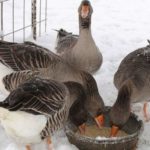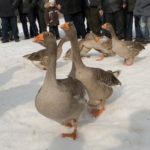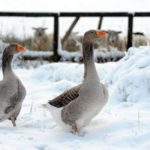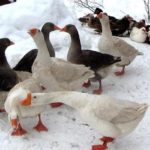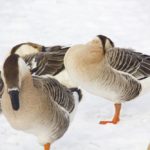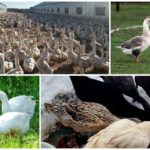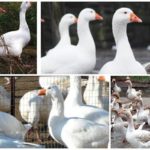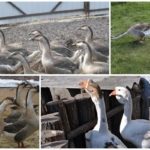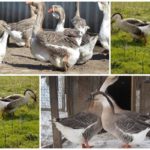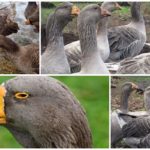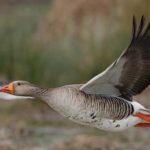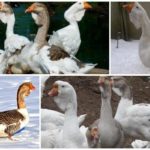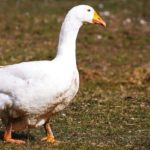With the arrival of cold weather, maintaining a poultry yard requires increased attention from farmers. Compared to other poultry house inhabitants, geese are more picky about conditions and diet. Breeders rightfully ask themselves the question of how often and what they should feed geese in winter so that the rate of weight gain and productivity of the birds does not fall during the cold season.
Why is winter feeding different?
Keeping geese in winter, it should be based on a complete diet that ensures replenishment of the lack of nutrients in the absence of fresh pasture, preservation of heat, harmonious development and health. In summer, birds are fed grain in the morning and evening, and geese consume most of their food while walking. In winter, conditions are limited, and food must provide all the needs of the bird.
When developing a winter menu, you need to consider that geese need:
- animal and vegetable protein;
- carbohydrates;
- cellulose;
- amino acids;
- vitamins and minerals.
All components must be present on the menu daily in sufficient quantities. The meal plan is changed gradually, moving from two meals a day to three, and then to four meals a day.
What to feed geese at home in winter
In the cold season, the food of geese should be enhanced, in comparison with the summer menu, and varied. But you shouldn’t feed the birds either. Obesity negatively affects the egg production of geese.
The basis of the winter diet of the inhabitants of the goose farm is:
- Corn. Grains are a source of carbohydrates for birds. Barley, oats, millet, wheat, and corn are suitable for geese. Barley grain is rich in B vitamins.
- Vegetables. Carrots, zucchini, beets, pumpkin, cabbage are given fresh, pre-chopped. You can offer boiled potatoes to the geese. Vegetables serve as a source of vitamins and plant fiber.
- Hay and silage. Grass makes up the main part of the geese's diet. In the absence of fresh greenery, the birds are offered dry or soaked chopped hay, and preparations in the form of brooms made from dried nettle, birch, and alder.Brooms can be given whole or added crushed to the mash.
- Legumes. Peas and beans are pre-soaked and given to geese to compensate for the deficiency of vegetable protein and B vitamins.
Bran, meal, and cake are added to food as a source of fiber. Twice feedings a day are left until December. In the morning, the geese are given mash, which is a soaked mixture of grains (1 part) and vegetables (1.5 parts) with various additives.
Additional ingredients may be:
- dried aquatic plants;
- vegetable pastes;
- vitamin complexes;
- yeast;
- meat and bone or fish meal;
- crushed eggshells;
- powdered pine needles;
- ready-made food additives.
In the evening feeding, the birds are given soaked grain. From January they switch to three meals a day. Cereals are offered twice a day, in the morning and evening feedings, and a moist mash of grains and vegetables is served for lunch. Or they give mash in the morning, hay and chopped vegetables in the afternoon, and grain in the evening.
After 3-4 weeks, a fourth feeding is introduced into the diet. A wet mixture of grains and vegetables is given twice a day. They also offer soaked or sprouted grain twice. Feeding is simplified by the use of ready-made feed mixtures, the composition of which is adapted to the needs of the birds.
What should you not give in winter?
From every food group there are types of food that can cause disruptions in the digestive system and cause serious illnesses.
The following foods should not be given to geese:
- fresh rye;
- moldy and spoiled food;
- potato broth;
- potatoes with sprouts and green fruits (contain solanine);
- hay containing seeds of poisonous plants (lily of the valley, quinoa, ragweed);
- brooms from tree branches containing a large amount of tannins (oak, willow).
It is necessary to monitor the salt content, which should be present in the diet, but in limited quantities - no more than 0.5 grams per day.
How to water geese?
Maintaining a drinking regime is an important part of keeping geese in the winter. Just like in summer, birds need water in winter. An adult drinks up to 2 liters of liquid daily.
A lack of water in the diet of geese causes a decline in productivity: females do not lay eggs well, and males have reduced sexual function.
Geese should have free access to fresh water. It is necessary to carefully monitor the filling of drinking bowls or install automatic drinking bowls that provide a constant flow of fresh portions of water. It is allowed to give birds melt water in winter. Snow is collected from areas remote from residential areas, animal walking areas and roadways.
Rules for caring for goslings
Within a few hours after the goslings hatch, you need to start feeding them. In the first week of life, chicks are allowed to be fed:
- chopped hard-boiled eggs;
- boiled millet, corn, barley porridge;
- semolina porridge;
- chopped oatmeal;
- grated beets, carrots.
In the second week of life, boiled mashed potatoes can be administered. Feed mixtures are selected according to age. In the first 10 days, they are given a starter mixture, then they switch to highly nutritious feed. The brood needs to be fed every 3 hours from birth to 7 days. By the age of two weeks, goslings are transferred to four meals a day. From 8 weeks of life, young animals are transferred to an adult diet.

